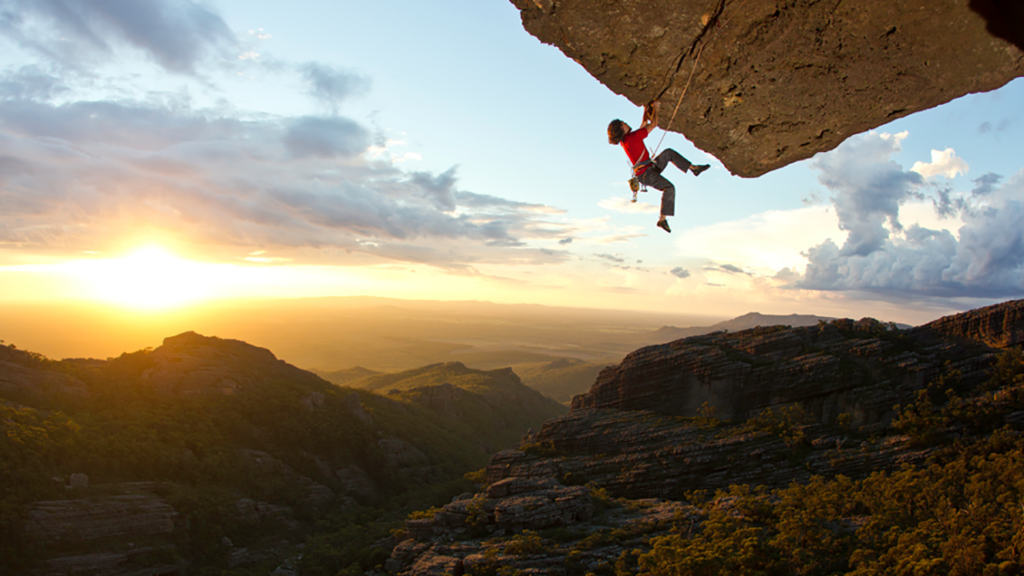 While rock climbing was previously thought of as an extreme sport, an increase in the number of climbing gyms in the past 30 years has made the sport more accessible and increasingly popular. As more non-skilled climbers have taken up the physically and emotionally challenging activity, they have put themselves at an increased risk of injury. Besides the risk posed by traumatic falls, physical therapists have also noticed an increase in overuse injuries. Due to the repetitive, high torque movements in rock climbing, we are seeing climbers push their abilities without proper form, technique or cross training.
While rock climbing was previously thought of as an extreme sport, an increase in the number of climbing gyms in the past 30 years has made the sport more accessible and increasingly popular. As more non-skilled climbers have taken up the physically and emotionally challenging activity, they have put themselves at an increased risk of injury. Besides the risk posed by traumatic falls, physical therapists have also noticed an increase in overuse injuries. Due to the repetitive, high torque movements in rock climbing, we are seeing climbers push their abilities without proper form, technique or cross training.
Hand and wrist injuries are the most common climbing overuse injuries. However, this article will focus on the knee and shoulder overuse injuries in new (and sometimes experienced) climbers. This sport requires power, strength, flexibility AND technique. Those who have an improper technique or who are untrained (ie. have poor core activation, shoulder instability or flexibility deficits) are at risk for an overuse injury. Climbers are also at risk of developing shortened latissimus dorsi, increased kyphosis and forward head posture, which can lead to upper crossed syndrome. (1-2)
In physical therapy, the injuries we tend to see with climbers are:
- Shoulder impingement: While this is the most common overuse injury, it is also the most treatable and preventable. Once the rotator cuff or bicipital tendon becomes injured, rest is the best treatment. Working out with weights to strengthen rotator cuff and scapular stabilizers for improved stability throughout shoulder is also recommended. (5)
- Shoulder Labral damage – This injury is becoming more common, and if the injury is too severe, it cannot be treated with surgery. There are several ways the labrum (connective tissue surrounding the socket that provides stability) is injured. SLAP (Superior Labrum Anterior to Posterior), Bankart, or Hills Sachs Lesion are the main injuries in the shoulder capsule. SLAP tears may occur from overuse of the bicep tendon (common with pulling movements) or putting the shoulder in awkward reaching back motions. Bankart and Hills Sachs are usually caused due to hypermobility or dislocations with down pressure or from a fall. (5)
- Lateral and posterior knee pain – Hamstring tendonitis or ligamentous instability, patellar tendonitis and ITB syndrome are the more common injuries during climbing. Hip rotation dysfunctions seen with toe in and out holds can lead to microtraumas in the knee. Usually this is seen with poor technique or flexibility deficits in the hip which may lead to instability. (5)
Long-term injuries—those lingering pains that never quite go away—keep individuals from doing the climbing that they love. Our goal, in physical therapy, is to make climbers mindful of the potential for chronic injury and give them a plan for injury prevention so that they can keep doing what they love. There are things that climbers can do to prevent further injury as well as rehabilitate current injuries. (6)
- Warm up and stretch: Jump on a bike for 5-10 minutes, doing yoga or gentle whole body exercises. This will allow your body’s core temperature to rise which will help the physiological systems.
- Work on imbalances: If hamstrings or hips are tight, stretch them. If your shoulder stability is lacking, perform shoulder and scapular stability exercises. Every climber could be working on preventative shoulder, core and hip stabilization exercises. This does not mean you should do more climbing. This means that you should perform specific exercises that isolate the weakness (rotator cuff, middle traps and hip rotators). If you are not sure about your imbalances, then speak with your physical therapist.
- Rest between climbs: The research shows climbing should not be performed more frequently than every other day in order to prevent injury resulting from fatigue or overuse. Cross training is your friend. Imbalance correction exercises should be done in between your climbing days. Not only will this improve your climbing performance, but it will prevent further injury. (1,6)
- Power training: This includes heavy strength training, explosive strength training and plyometrics. It will not only prevent injuries but significantly improve your climbing.
- TECHNIQUE: Practice, practice, practice! Take beginner and intermediate courses and workout with experienced climbers. This is the most important aspect of prevention. Lastly, have fun with it!
Overuse injuries most commonly occur to the upper extremities. We touched on shoulders, however hands and elbows are particularly susceptible because of the mechanical stresses of the sport. There continues to be more research by physical therapists to determine the unique demands on the body that will require study to help create better training and movement strategies. Until then, climbers should focus on technique, strengthening and being mindful to fully enjoy the sport that they love.
References
1.) Addiss DG, Baker SP: Mountaineering and rock climbing injuries in US national parks. Ann Emerg Med 18:975-979, 1989
2. ) Bannister P, Foster P: Upper limb injuries associated with rock climbing. Br J sports Med 20:55, 1986
3.) www.Rockclimbingforlife.com; Tips to an climbing injury free season
4.) www.Theclimbingdoctor.com: Jared Vagey: “How to train antagonist muscle strength for climbing”
5.) www.ptjess.wordpress.com/injuries in climbing; 2017
6.) Maitland, BSR, MSc, PT: Injuries assocaited with Rock climbing. 1992

